What is aquarium KH? How does KH affect fish? How is KH connected to GH? Why is KH important? These and many other questions will be answered in this blog post.
You can also find out how to check your water’s KH levels, what causes variation in KH, and what happens when there are high or low levels of KH. We’ll also cover some common misconceptions about water chemistry that may lead you astray.
What is KH?
KH is the carbonate hardness in your aquarium. By carbonate we mean calcium carbonate. The k is used instead of the c because of the German spelling of Karbonate. Hence KH.
It also indicates the bicarbonates in the aquarium. It’s an important parameter because it affects the pH. In simple terms, KH prevents the harmful nitrates in the tank from altering the pH.
Some people compare KH to the ozone layer of the earth. It essentially performs a protective or rather a barrier function by preventing pH fluctuations which is very important for the aquarium.
Hence, KH is also referred to as the Total Alkalinity or Acid Neutralizing Capacity (ANC).
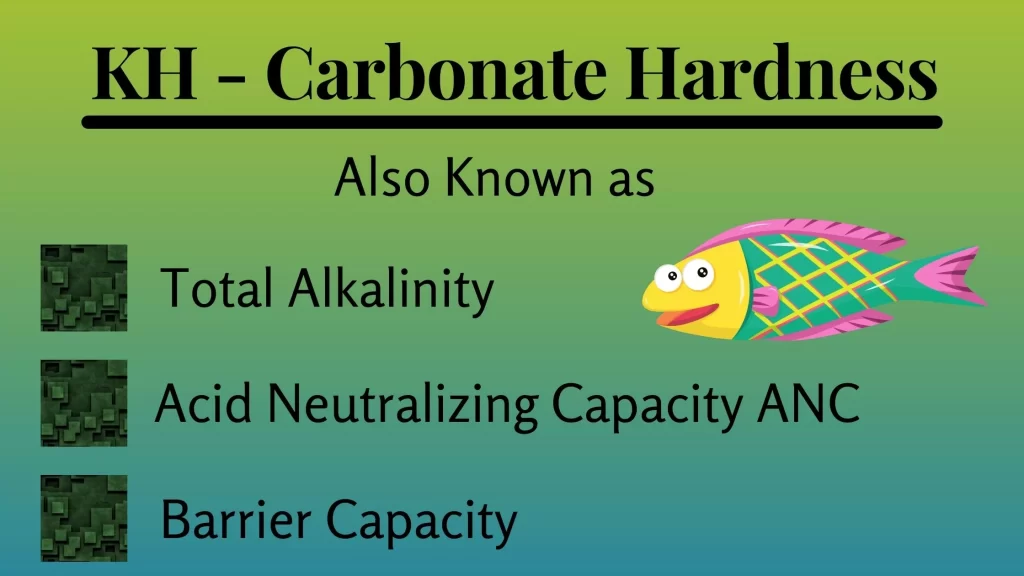
How Is KH measurement expressed?
The KH is expressed in terms of degrees or parts per million(ppm) 1 degree is 17.85 ppm.
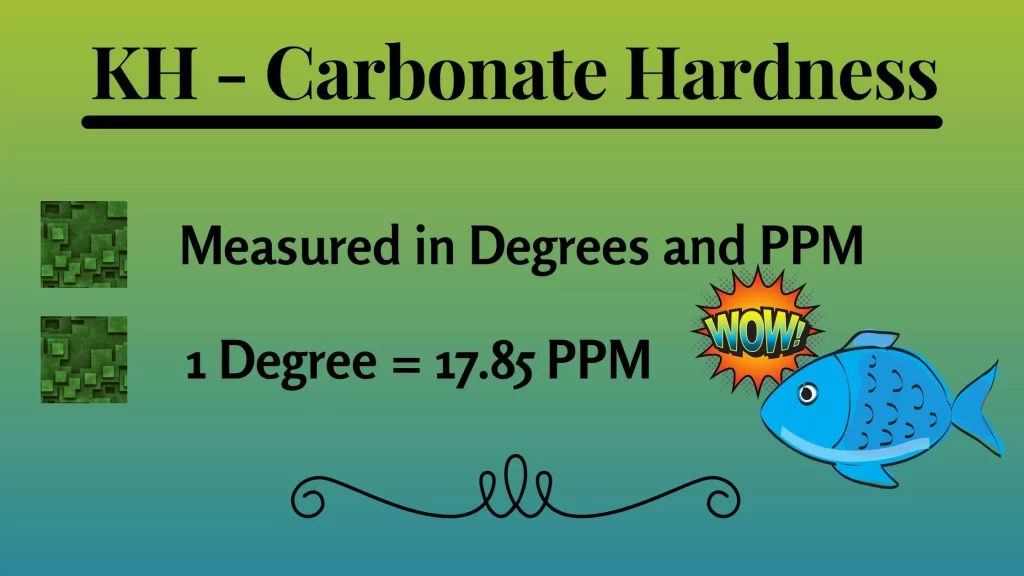
How Does KH Affect Fish?
KH affects fish by allowing the pH to fluctuate. So, you can definitely say that the pH requires KH for its stability.
One need not worry too much about KH if the pH is just fine and the fish are doing fine. The need for investigating will arise when something goes wrong in your tank and you need to find out the cause before deciding your solution.
KH also affects fish because the amount of bicarbonates in the aquarium are related to the quantity of CO2(carbon dioxide) present in the water. The less CO there is, the higher the pH. If the C02 increases, the pH decreases.
KH is a nutrient which the good bacteria need to help with the nitrification cycle (ammonia is converted to nitrite and then to nitrate). This keeps your tank healthy and stable.
As you can see from these numbers how important KH has become for aquarists, especially if there are species that are sensitive towards their living conditions or have special requirements when it comes to water chemistry.
It makes sense to have a general understanding about this parameter is beneficial for people who want to take care of their aquarium.
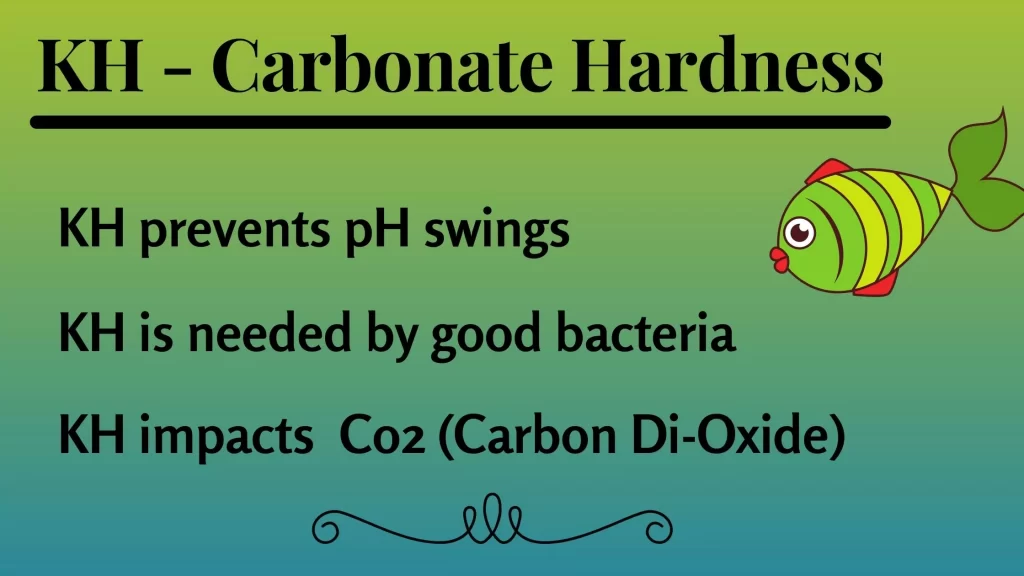
How Is KH Connected To GH?
KH is connected to GH (general hardness of your water). Tap water will have both of them while pure freshwater has zero calcium or magnesium content.
The basic concept is this. When you increase KH, that’s the calcium carbonate, the calcium ions increase. When that happens, the natural consequence is that the GH will also increase.
Pro Tip: KH and GH work together to keep the pH stable. This is the most important thing to remember. So if your pH is stable and good, do not meddle with KH and GH unless the fish show symptoms.
KH and GH are measured in the same units, ppm or dKH/dGH (degree of carbonate hardness). In other words, every number you see on a test kit for either parameter means exactly the same thing.

What Causes Variation In KH?
The causes of variation in KH are manifold. If you think about it, a fish tank is an enclosed ecosystem where every living thing inside exchanges chemicals with the environment.
So this means that there will be changes if one or more factors change (for example amount of waste produced by inhabitants).
There are five main causes why KH can vary. The first cause is infrequent water changes. KH gets depleted during the nitrification cycle.
If the water changes are not done regularly, the KH is not replenished. This results in lower KH.
The second reason is overcrowding a tank. This is because, the more the fish, the more nitrification that occurs and therefore the KH is lower at a faster pace.
This is very dangerous for the fish since the pH begins fluctuating. So, depending on the number of fish in the tank, you will have to do water changes to supplement the KH.
The third reason is excess CO2. Carbon di-oxide dissolves into water to become carbonic acid. This in turn increases the acidity of the water. If you do not have live plants in the aquarium, then it can so happen that the acidic content in the water is more.
If you do have plants, then the excess that is not absorbed poses a threat to the tank. Then, the KH handles as much as it can. However, as the KH starts lowering, the pH fluctuates. This is then a vicious circle which needs to be broken.
The fourth is how much you feed your fish. It may happen that you use more than required food to feed your fish. Under these circumstances, more waste is generated in the tank. This affects the nitrification and thus the KH.
Pro Tip: Most people tend to feed fish an unmeasured quantity each time. It would be best if use a spoon or measure the food.
The fifth reason is the light your plants get. Plants need light to indulge in Photosynthesis.
In the absence of light, the plants will allow more CO2 to remain in the water thus affecting the KH. So lighting does play a role in the KH and the pH of the tank.
The sixth reason is the temperature of the water. One may wonder how this could be a factor at all. Let us see why.
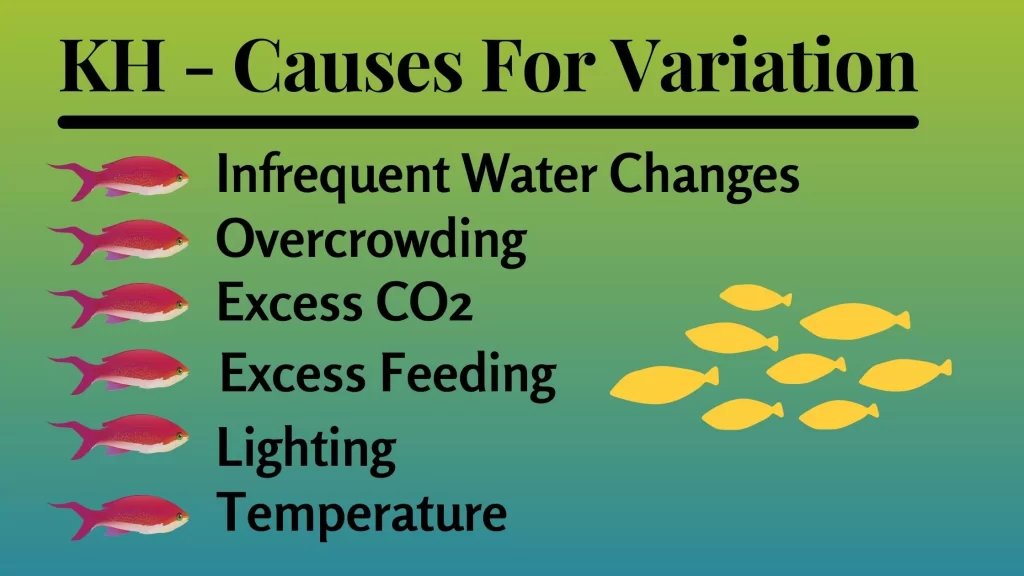
What Happens If There Is High KH?
One possible effect would be increased pH stability due to the presence of bicarbonate ions. However, if you are trying to reduce the pH of your tank, then a high KH can affect it.
High KH can impact the pH and thus affect the fish negatively. As we all know, too much is always too bad. Other than this its only low KH that can be a cause to worry.
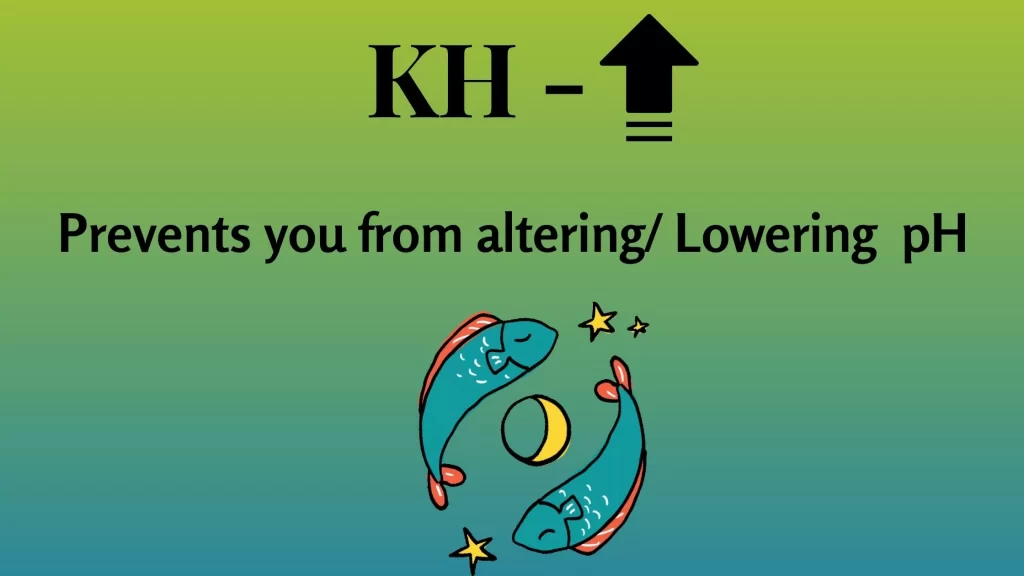
What Happens If There Is Low KH?
The opposite effects are also possible & this time, you can expect very unstable pH levels because not enough carbonates and bicarbonates will be around anymore.
This means there are going to be pH fluctuations which are not going to be automatically handled. Naturally the fish are going to impacted without your even knowing it if you aren’t testing regularly.
The second thing this will mean is your frequent intervention will be necessary involving more maintenance.
Some types of fish have evolved specifically so they could deal with acidic water but most don’t so their lives will become miserable without proper care.
But even worse than this are cases where KH drops too fast or down to zero. If this happens, the only thing that will remain is carbonic acid (H²CO³) which can be pretty deadly because it’s even more acidic than pure H!
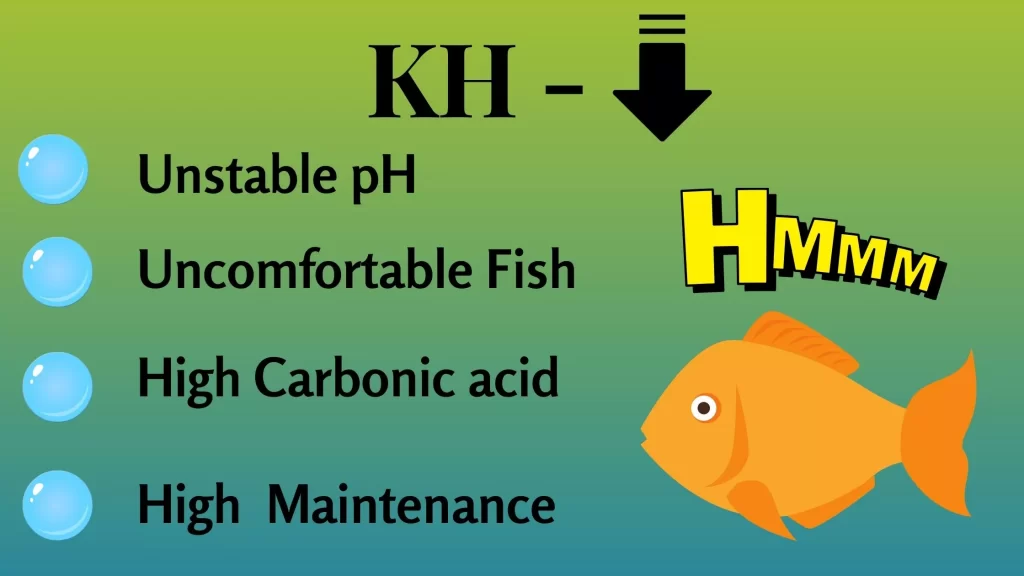
When Do You Check KH?
There are two times in particular where testing for KH is very recommended. First, before adding any new fish to your tank and after a water change.
The former one ensures that there won’t be any issues with respect to pH/KH values while the latter helps avoid sudden drops & increases.
You might think twice about checking these numbers every day since it takes time but if you want to keep things running smoothly then I’d say at least once per week would suffice.
Of course, if you’re using a complete liquid test kit then this is even easier since all that’s required from your part would be to bring the water sample up to light and read it.
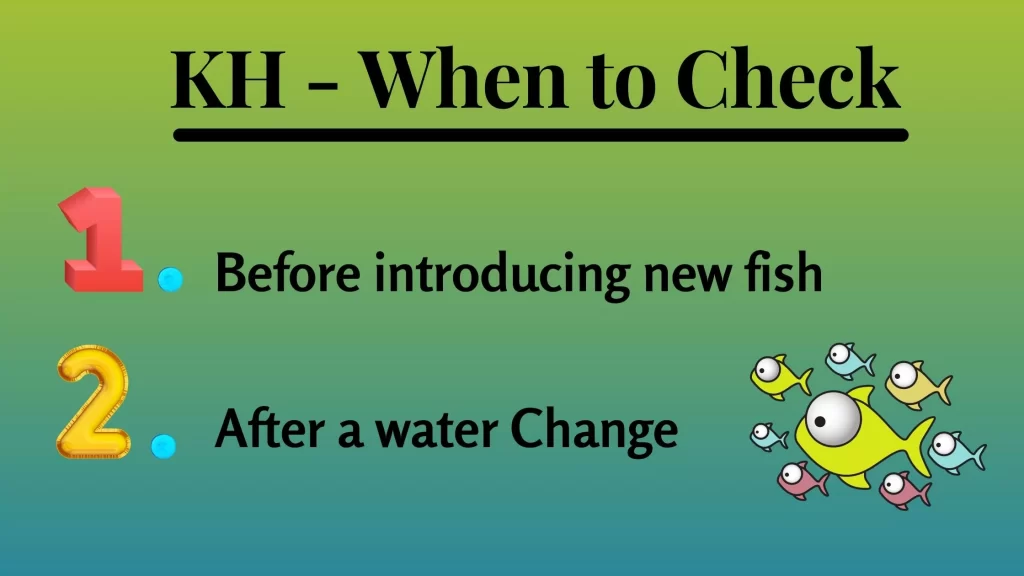
How To Test KH?
KH can be tested by readily available kits. One of the available kits is the API Testing Kit. Take a test tube with 5ml of water and add a drop of the solution provided. Close the cap and invert it.
If it turns yellow, stop right there. If not, add another drop. Continue this procedure until it turns yellow. Remember to invert it each time.
Once it turns yellow, compare the number of drops used to the chart provided by API. You will then know the KH in your tank.
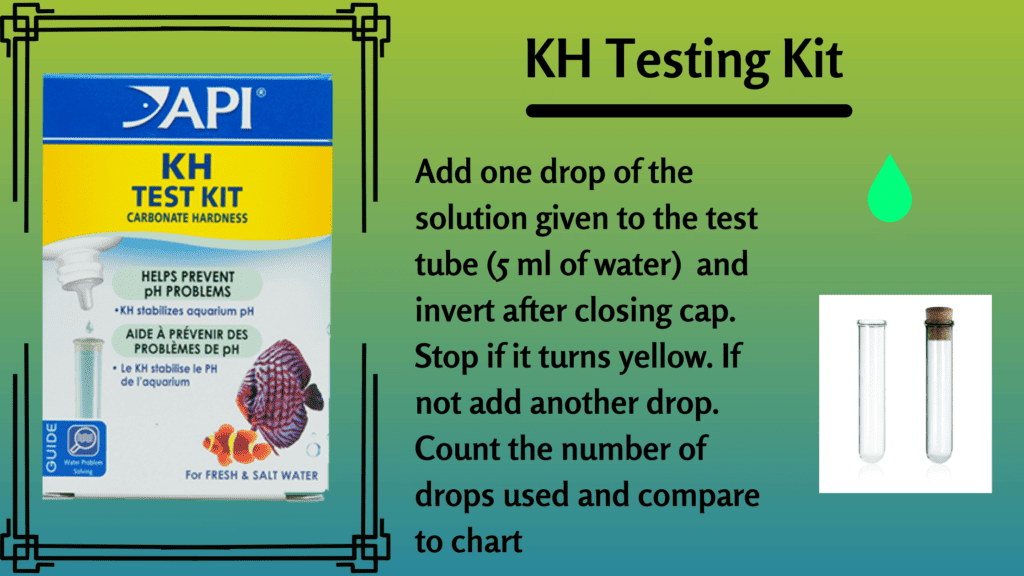
What Is The Ideal KH Level?
Having understood, KH, its impact and causes, let us now look at what is the ideal KH required. First it is important that you know that all types of fish do not require the same level of KH.
A medium range of KH is 4-8 Degrees. Poecilidae family need 8 – 10 Degrees. The Cichlid family always expect more than 10 Degrees.
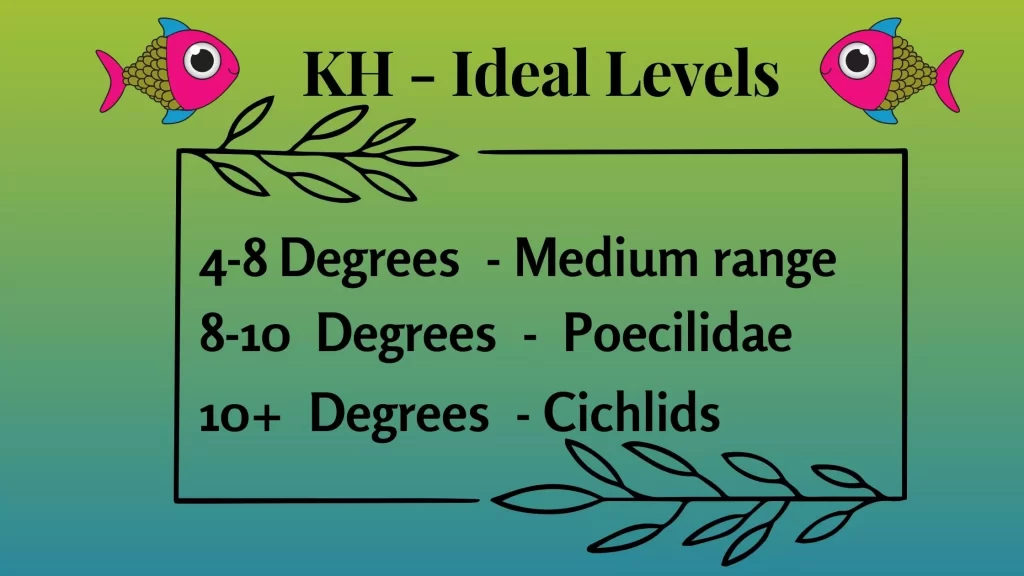
What Are The Ways Of Lowering KH?
Generally, there may not be a situation where you need to lower the KH. More often, it is the increase of KH that people look at.
However, if the situation does arise, then here are the methods that you should be looking at.
Using RO (reverse osmosis) water. A water-change of 30-40% depending on the level of your KH. You can remove the existing tank water and adding RO water could lower the KH levels in your tank.
Checking the CO2 levels in your aquarium using a kit. If you do find higher levels of CO2 then introducing a few more plants could help.
Using distilled water (DI) is another solution. Again, a water change with distilled water will bring down the KH.
Another method is to use Almond leaves. These leave release tannins in the water and help lower the KH.
However, if you’re very particular about the color of the water, then this is not the option for you. The tannins change the color of your water and the water could look like tea. In a similar way peat moss is also recommended.
Pro Tip:- You can use rain water. However, you have to be extremely careful because rain water can be polluted, infectious, dirty and acidic too. So, unless you have tested your rain water it is not advisable.
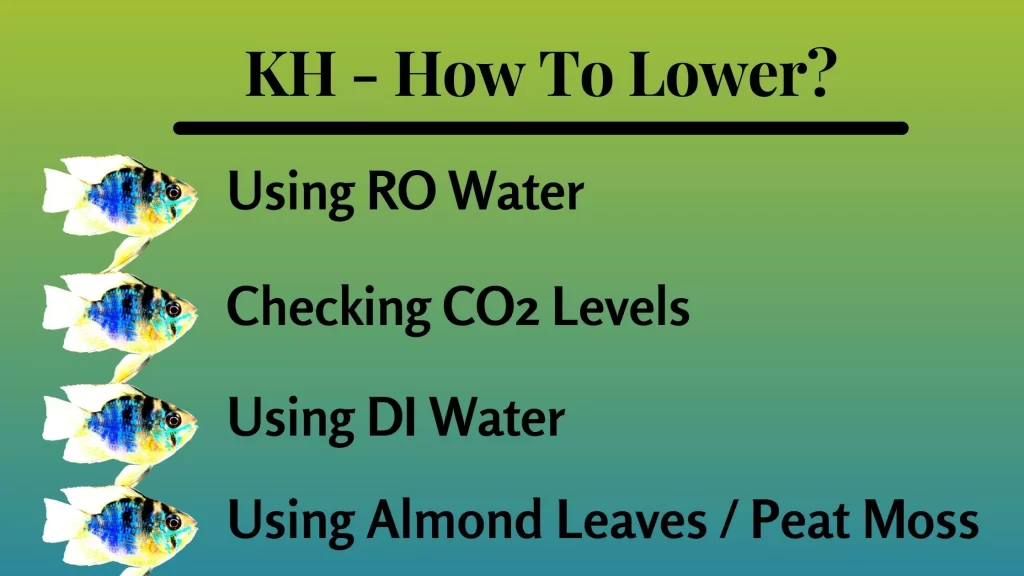
What Are The Ways Of Increasing KH In Your Aquarium?

The most recommended method is using coral sand. One of the tested brands is argonite. However, you must remember that crushed coral will take about four days to actually give you results.
This is actually good, because a fast reduction can shock your fish. This method does not involve any chemicals. So that makes it another reason why coral sand is recommended.
A word of caution here is if you have snails or hermit crabs because they can ingest the sharp pieces. This is why it is recommended that the coral sand is placed in mesh bags before using it.
Coral sand is a good method for maintaining KH which doesn’t require any further preparation or pre-filtering so it saves you time & effort. All it needs is a rinsing before use.

You could also use substrate. However, you must remember that there are different types of substrates and you must be careful while selecting the type of substrate.
Although generally substrates are beneficial in several ways, they may not exactly serve your purpose if you do not do your research. ADA Soil Amazonia is recommended as one of the best options in such cases.

The next method is using limestone. Limestone contains calcium carbonate and thus increases the KH.
However, the presence of calcium has a direct bearing on the KH and therefore it is necessary to ascertain your GH before using limestone.

Cuttlebone (sepia officinalis) is another good way of raising KH but it’s not the most efficient one. Cuttlebones have to be placed in a netted bag and allowed to remain the water like the coral sand bag.
Just place a rock in the bag to help it sink. Boiling the cuttlebone is not advisable because it can be harmful. Do remember to rinse it before using it.

Another method is using coconut husk with your substrate. This has to be done carefully and it could dirty your water.
Using netted bags whose nets are closely constructed could prevent the coconut fibre or husk form getting into your water. Even then, there are chances that the water can still get murky.
Also, you will need to know the exact quantity to be used before you engage in this method.

The next method is using ready-made additives from the store. Be careful to purchase from trustworthy stores and opt only for reputed brands and follow the instructions provided by them.

Baking soda (NaHCO³) is another way of raising KH and it’s also one of the cheapest methods. But keep in mind that this method might not be suitable for tanks with very sensitive fish because even though they won’t show any signs, their lives will become harder as time passes.
This should probably be your last option more so only when you need a smaller quantity. In fact, I wouldn’t recommend it at all. Baking soda may even end up increasing the hydrogen levels instead of the carbonate levels thus not being an efficient method of handling KH.

Another method is the usage of potassium bicarbonate. This however is an artificial method and I would recommend trying the natural methods before you use potassium bicarbonate. People prefer this to baking soda and that actually makes sense.
Pro Tip: Some recommend usage of snow. However, snow can be contaminated and can affect the temperature of the aquarium. Hence, it is not advisable.
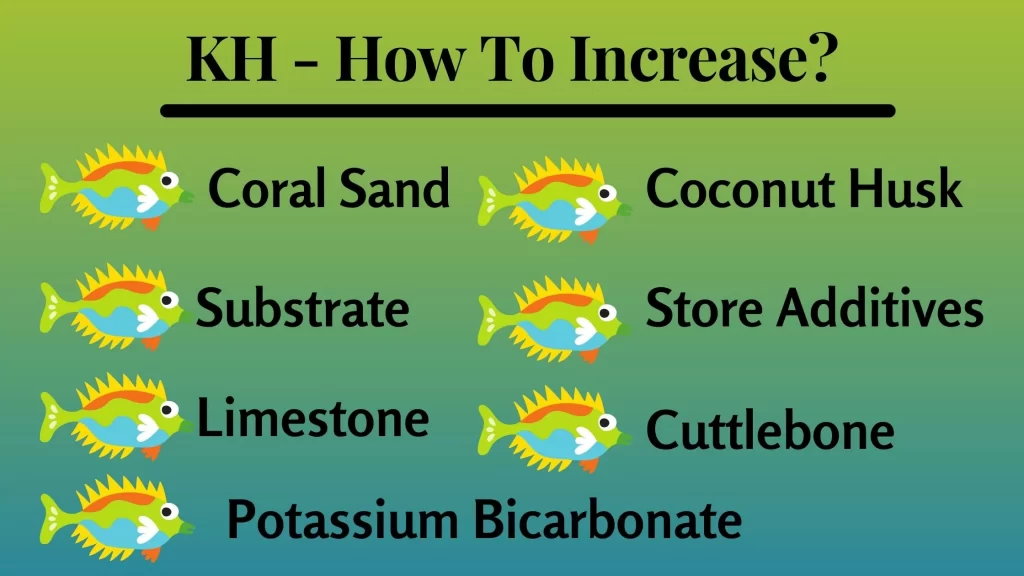
Wrapping Up:
knowing what aquarium KH means can help you better understand how things work so you could make adjustments as needed. But the most important thing is not just understanding but caring for aquatic life properly! If something goes wrong or changes aren’t being made accordingly, there might come a time where everything falls apart & this will lead to irreversible damage – for both organisms AND equipment! So be aware of these numbers and take proper steps whenever necessary.
Related Questions:
How Does KH Affect Plants?
Plants can generally tolerate a good level of pH unless it goes above 8. That is when you should really look at your pH. However, before you decide to alter the levels of your pH or KH you should consider the benefits of it for fish vs plants. You may want to look at other alternatives before actually altering KH for the sake of your plants. Also the type of fish in your tank, their capacity to withstand pH fluctuation.

